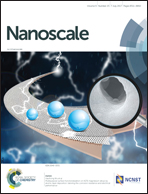Silicon anodes protected by a nitrogen-doped porous carbon shell for high-performance lithium-ion batteries†
Abstract
Silicon (Si) anodes, which are among the most promising candidates for high-energy lithium-ion batteries (LIBs), have attracted considerable attention from both academic and industrial communities. However, Si anodes usually suffer from an inherently low conductivity and extremely large volume change during the lithiation and delithiation processes, and consequently exhibit an inferior rate capability and poor cycle life. In this paper, we report new porous polymer-derived carbon coated Si nanoparticles (NPs) as the next generation anodes for LIBs to overcome these serious problems. Specifically, a porous covalent triazine framework (CTF) polymer shell was synthesized by in situ trimerization of p-benzenedinitrile in molten ZnCl2. Then, core–shell structured Si/nitrogen-doped porous carbon (Si@NPC) spheres were easily produced after high-temperature annealing. As an anode for LIBs, Si@NPC delivers a high capacity of 1390 mA h g−1 at 0.5 A g−1, stable cycle performance (107% capacity retention at 1 A g−1 for 200 cycles), and excellent rate capability of up to approximately 420 mA h g−1 at 16 A g−1. Such an exciting performance can be attributed to the ultra-stable, highly conductive, N-doped, and porous carbon shell. This work not only offers a new solution to the large volume change of Si-based anodes, but also enables the synthesis of porous polymer-based core–shell structures for energy storage and conversion.



 Please wait while we load your content...
Please wait while we load your content...